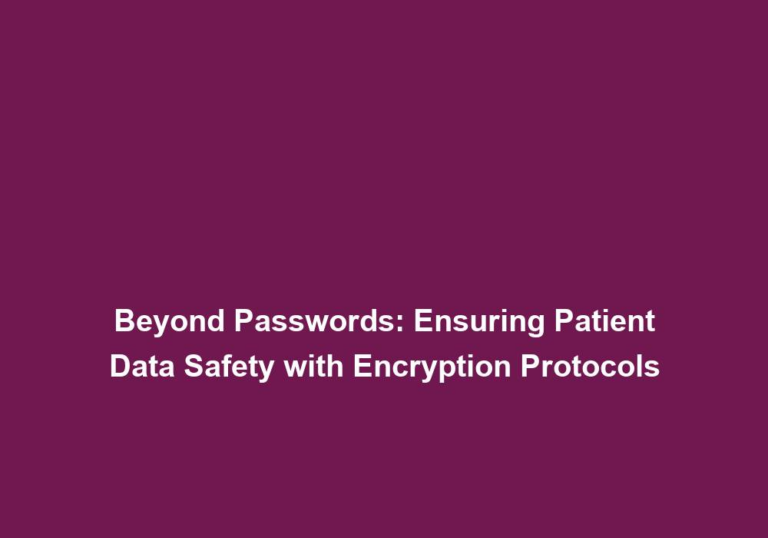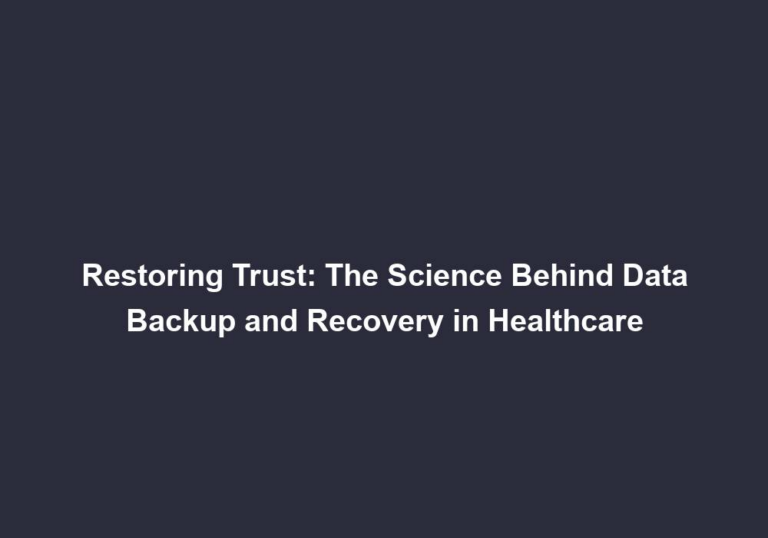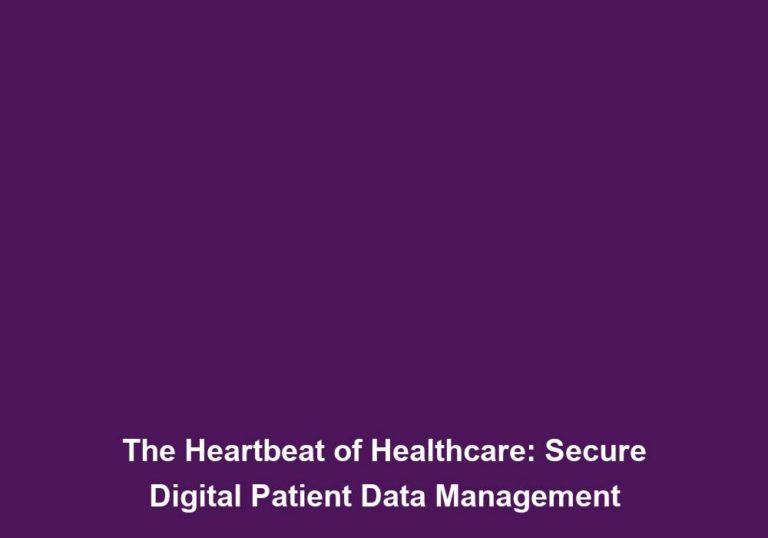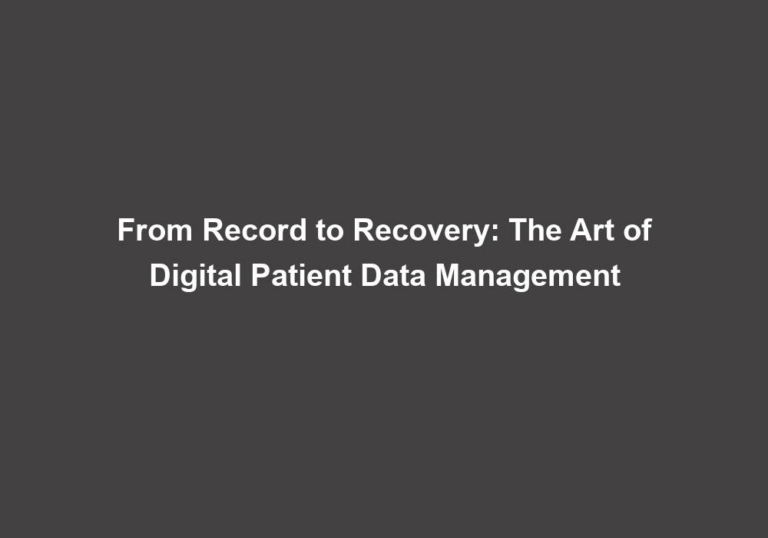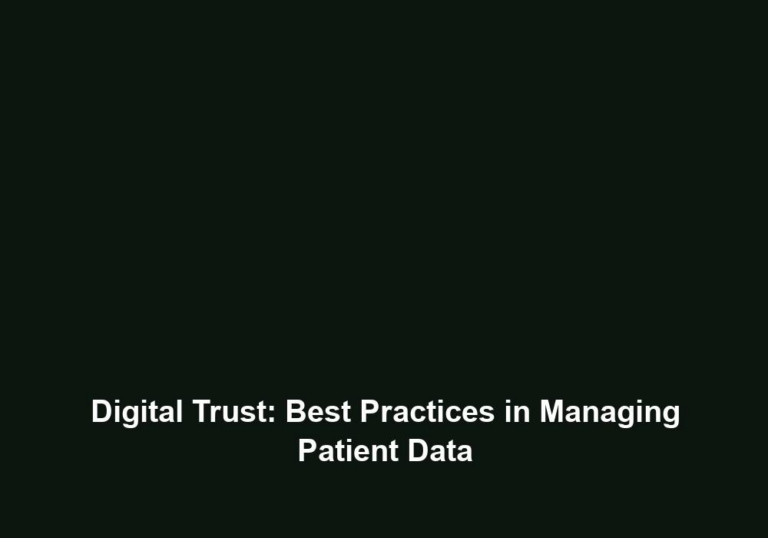Safety Nets for Health Data: Crafting Efficient Backup and Recovery Plans
In today’s digital age, health data has become an invaluable asset for healthcare organizations and professionals. With the increasing reliance on technology and electronic health records (EHRs), it is crucial to have robust backup and recovery plans in place to ensure the safety and integrity of this sensitive information. In this article, we will discuss the importance of safety nets for health data and provide insights into crafting efficient backup and recovery plans.
Why Backup and Recovery Plans are Essential for Health Data
Health data encompasses a wide range of information, including patient records, medical histories, test results, and treatment plans. Losing or compromising this data can have severe consequences, both for patients and healthcare providers. Let’s explore some of the reasons why backup and recovery plans are essential for health data.
-
Data Loss Prevention: Accidental deletion, hardware failures, software glitches, or cyberattacks can result in the loss of critical health data. A robust backup plan ensures that data can be recovered swiftly in the event of such incidents, minimizing disruption and preventing potential legal and financial liabilities.
-
Compliance with Regulations: Healthcare providers are bound by various regulations, such as the Health Insurance Portability and Accountability Act (HIPAA) in the United States. These regulations mandate the protection and privacy of patient information, including the need for data backups. By implementing backup and recovery plans, healthcare organizations can demonstrate compliance and avoid penalties. Additionally, backups are crucial for meeting the requirements of other regulations, such as the General Data Protection Regulation (GDPR) in the European Union.
-
Continuity of Care: In the healthcare sector, time plays a crucial role. Interruptions or delays in accessing patient data can hinder the delivery of quality care. Efficient backup and recovery plans ensure that health data is readily available and accessible, enabling healthcare professionals to provide timely and accurate treatments. This ensures that patient care is not compromised, and medical decisions can be made based on complete and up-to-date information.
-
Protection against Cyber Threats: The healthcare industry is increasingly becoming a target for cyberattacks due to the value of health data. Ransomware attacks, data breaches, and other cyber threats pose significant risks to patient privacy and organizational reputation. Backup and recovery plans serve as a safety net, allowing organizations to restore their systems and data in the face of an attack. Implementing security measures, such as encryption and regular testing of recovery procedures, enhances the resilience of the backup systems and helps mitigate the impact of potential cyber threats.
Crafting Efficient Backup and Recovery Plans for Health Data
Designing effective backup and recovery plans for health data requires careful consideration of various factors. By following these best practices, healthcare organizations can ensure the integrity and availability of their critical information.
1. Understand Data Criticality
Not all health data holds the same level of importance. It is essential to identify the different types of data within your organization and classify them based on their criticality. For instance, patient records and treatment plans may be assigned a higher priority than administrative files. This classification will help allocate resources and prioritize backup and recovery efforts accordingly. By understanding the criticality of data, organizations can ensure that the most crucial information is protected effectively.
2. Conduct Risk Assessments
Performing regular risk assessments is vital to identify vulnerabilities and potential threats to health data. By understanding the risks, organizations can make informed decisions regarding backup frequency, storage options, and recovery time objectives (RTOs). Engage IT professionals or specialized security consultants to evaluate existing systems and recommend appropriate measures. Risk assessments help identify weaknesses in the backup and recovery plans and enable organizations to take proactive steps to address them.
3. Determine Backup Frequency and Retention Periods
The frequency of data backups should be determined based on the criticality of the information and the acceptable level of data loss. Consider factors such as the volume of data generated, the rate of change, and the resources available for backup operations. Additionally, establish retention periods for backups, taking into account legal requirements, business needs, and storage costs. This ensures that backups are performed at appropriate intervals and that data is retained for an adequate period.
4. Implement Redundancy and Geographic Distribution
To enhance data resiliency, consider implementing redundancy by storing backups in multiple locations. This protects against localized disasters such as fires or natural calamities. Distributing backups in geographically diverse sites also mitigates the risk of data loss due to regional disruptions, ensuring business continuity in the face of unforeseen events. Redundancy and geographic distribution improve the chances of successful data recovery and minimize the impact of localized incidents.
5. Encrypt Backups and Test Recovery Procedures
To maintain the confidentiality and integrity of health data, encrypt backups during storage and transmission. Encryption adds an extra layer of security, ensuring that even if unauthorized individuals gain access to the backup files, the data remains protected. Additionally, regularly test recovery procedures to validate the effectiveness of the backup plan and identify any potential shortcomings. Testing recovery procedures helps identify any weaknesses in the backup and recovery process and allows organizations to make necessary improvements to ensure successful data recovery.
6. Train Staff and Raise Awareness
A crucial aspect of crafting efficient backup and recovery plans is ensuring that staff members are well-trained and aware of their roles and responsibilities. Conduct regular training sessions to educate employees on data backup procedures, emphasize the importance of data security, and provide guidelines for handling potential data loss incidents. By training staff and raising awareness, organizations can ensure that everyone understands the significance of backup and recovery plans and their individual contributions to maintaining data integrity.
7. Monitor and Update Backup Systems
Backup and recovery plans should not be set in stone. It is essential to regularly monitor and evaluate the effectiveness of backup systems, making necessary updates and adjustments as technology evolves and new threats emerge. Stay informed about the latest industry standards and best practices to ensure that the backup and recovery processes remain efficient and up to date. Regular monitoring and updating of backup systems help ensure that healthcare organizations are equipped with the most effective tools and strategies to protect health data.
Conclusion
In conclusion, crafting efficient backup and recovery plans is crucial for safeguarding health data in today’s technology-driven healthcare landscape. By understanding the importance of safety nets for health data and implementing robust backup strategies, healthcare organizations can protect sensitive information, ensure business continuity, and provide quality care to their patients. Remember, a comprehensive backup and recovery plan is not only a legal requirement but also a fundamental aspect of responsible and reliable data management in the healthcare industry.


